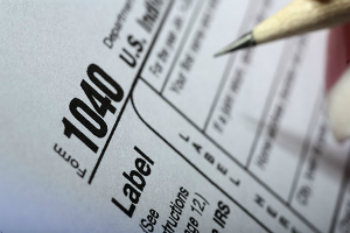
Overview of Federal Income Taxes
Income in America is taxed by the federal government, most state governments and many local governments. The federal income tax system is progressive, so the rate of taxation increases as income increases. Marginal tax rates range from 10% to 37%.
| Household Income Dismiss | Location Dismiss | Filing Status |
| Advanced | |||
| 401(k) Contribution Dismiss | IRA Contribution Dismiss | Itemized Deductions Dismiss | Number of State Personal Exemptions Dismiss |
Have Questions About Your Taxes?
A financial advisor may be able to help. Match with an advisor serving your area today.
Your Income Taxes Breakdown
| Tax Type | Marginal Tax Rate | Effective Tax Rate | 2025 Taxes* |
| Federal | |||
| FICA | |||
| State | |||
| Local | |||
| Total Income Taxes | |||
| Income After Taxes | |||
| Retirement Contributions | |||
| Take-Home Pay |
* These are the taxes owed for the 2025 - 2026 filing season.
Your 2025 Federal Income Tax Comparison
- Your marginal federal income tax rate
- Your effective federal income tax rate
- Your federal income taxes
Total Estimated 2025 Tax BurdenIncome Tax $ Sales Tax $ Fuel Tax $ Property Tax$ Total Estimated Tax Burden $ Percent of income to taxes = % | $ |
- About This Answer
Our income tax calculator calculates your federal, state and local taxes based on several key inputs: your household income, location, filing status and number of personal exemptions.
How Income Taxes Are Calculated
- First, we calculate your adjusted gross income (AGI) by taking your total household income and reducing it by certain items such as contributions to your 401(k).
- Next, from AGI we subtract exemptions and deductions (either itemized or standard) to get your taxable income. Exemptions can be claimed for each taxpayer as well as dependents such as one’s spouse or children.
- Based on your filing status, your taxable income is then applied to the the tax brackets to calculate your federal income taxes owed for the year.
- Your location will determine whether you owe local and / or state taxes.
- Last Updated: January 1, 2026
When Do We Update? - We regularly check for any updates to the latest tax rates and regulations.
Customer Service - If you would like to leave any feedback, feel free to email info@smartasset.com.
Taxes can really put a dent in your paycheck. But with a Savings or CD account, you can let your money work for you. Check out these deals below:
The Federal Income Tax: How Are You Taxed?

The federal personal income tax that is administered by the Internal Revenue Service (IRS) is the largest source of revenue for the U.S. federal government. Nearly all working Americans are required to file a tax return with the IRS each year. In addition to this, most people pay taxes throughout the year in the form of payroll taxes that are withheld from their paychecks.
Income taxes in the U.S. are calculated based on tax rates that range from 10% to 37%. Taxpayers can lower their tax burden and the amount of taxes they owe by claiming deductions and credits.
Federal Income Tax: W-2 Employees
W-2 employees are workers that get W-2 tax forms from their employers. These forms report the annual salary paid during a specific tax year and the payroll taxes that were withheld.
This means that employers withhold money from employee earnings to pay for taxes. These taxes include Social Security tax, income tax, Medicare tax and other state income taxes that benefit W-2 employees.
Both employers and employees split the Federal Insurance Contribution Act (FICA) taxes that pay for Social Security and Medicare. The FICA rate due every pay period is 15.3% of an employee’s wages. However, this tax payment is divided in half between the employer and the employee.
Federal Income Tax: 1099 Employees
Independent contractors, unlike W-2 employees, will not have any federal tax deducted from their pay. This means that because they are not considered employees, they are responsible for their own federal payroll taxes (also known as self-employment tax).
Both 1099 workers and W-2 employees must pay FICA taxes for Social Security and Medicare. While W-2 employees split the combined FICA tax rate of 15.3% with their employers, 1099 workers are responsible for the entire amount.
The IRS requires employers to send 1099 forms to workers who are paid more than $600 during a tax year.
A financial advisor can help you understand how taxes fit into your overall financial goals. SmartAsset’s free tool matches you with vetted financial advisors who serve your area, and you can have a free introductory call with your advisor matches to decide which one you feel is right for you. If you’re ready to find an advisor who can help you achieve your financial goals, get started now.
Calculating the Federal Income Tax Rate
The United States has a progressive income tax system. This means there are higher tax rates for higher income levels. These are called “marginal tax rates," meaning they do not apply to total income, but only to the income within a specific range. These ranges are referred to as brackets.
Income falling within a specific bracket is taxed at the rate for that bracket. The table below shows the tax brackets for the federal income tax, and it reflects the rates for the 2025 tax year, which are the taxes due in April 2026.
You’ll notice that the brackets vary depending on whether you are single, married or a head of household. These different categories are called filing statuses. Married persons can choose to file separately or jointly. While it often makes sense to file jointly, filing separately may be the better choice in certain situations.
Based on the rates in the table above, a single filer with an income of $50,000 would have a top marginal tax rate of 22%. However, that taxpayer would not pay that rate on all $50,000. The rate on the first $11,925 of taxable income would be 10%, then 12% on the next $36,550, then 22% on the final $1,525 falling in the third bracket. This is because marginal tax rates only apply to income that falls within that specific bracket. Based on these rates, this hypothetical $50,000 earner owes $5,914, which is an effective tax rate of about 11.8%.
Tax Withholding Estimator: Calculating Taxable Income Using Exemptions and Deductions
Federal tax rates apply only to taxable income. This is different than your total income, otherwise known as gross income. Taxable income is always lower than gross income since the U.S. allows taxpayers to deduct certain income from their gross income to determine taxable income.
To calculate taxable income, you begin by making certain adjustments from gross income to arrive at adjusted gross income (AGI). Once you have calculated adjusted gross income, you can subtract any deductions for which you qualify (either itemized or standard) to arrive at taxable income.
Note that there are no longer personal exemptions at the federal level. Prior to 2018, taxpayers could claim a personal exemption, which lowered taxable income. The tax plan signed in late 2017 eliminated the personal exemption, though.
Deductions are somewhat more complicated. Many taxpayers claim the standard deduction, which varies depending on filing status, as shown in the table below.
Some taxpayers, however, may choose to itemize their deductions. This means subtracting certain eligible expenses and expenditures. The most common itemized deductions include:
- Deduction for state and local taxes paid: Also known as the SALT deduction, it allows eligible taxpayers in 2025 to deduct up to $40,000 of any state and local property taxes plus either their state and local income taxes or sales taxes. The SALT deduction rises to $40,400 in 2026.
- Deduction for mortgage interest paid: Interest paid on the mortgages of up to two homes, with it being limited to your first $1 million of debt. Homes purchased after Dec. 15, 2017 have this lowered to the first $750,000 of the mortgage.
- Deduction for charitable contributions
- Deduction for medical expenses that exceed 7.5% of AGI
Keep in mind that most taxpayers don’t itemize their deductions. If the standard deduction is larger than the sum of your itemized deductions (as it is for many taxpayers), you'll receive the standard deduction.
Once you have subtracted deductions from your adjusted gross income, you have your taxable income. If your taxable income is zero, that means you do not owe any income tax.
How to Calculate Federal Tax Credits

Unlike adjustments and deductions, which apply to your income, tax credits apply to your tax liability, which means the amount of tax that you owe.
For example, if you calculate that you have tax liability of $1,000 based on your taxable income and your tax bracket, and you are eligible for a tax credit of $200, that would reduce your liability to $800. In other words, you would only owe $800 to the federal government.
Tax credits are only awarded in certain circumstances, however. Some credits are refundable, which means you can receive payment for them even if you don’t owe any income tax. By contrast, nonrefundable tax credits can reduce your liability no lower than zero. The list below describes the most common federal income tax credits.
- The Earned Income Tax Credit is a refundable credit for taxpayers with income below a certain level. The 2025 credit can be up to $8,046 for taxpayers with three or more children ($8,231 for tax year 2026), or lower amounts for taxpayers with two, one or no children.
- The Child Tax Credit is worth up to $2,200 per qualifying child ($1,700 of which is refundable) for the 2025 tax year.
- The Child and Dependent Care Credit is a nonrefundable credit of up to $3,000 for one child or $6,000 for two or more children related to childcare expenses incurred while working or looking for work.
- The Adoption Credit, a credit for expenses related to the adoption of a child, is partially refundable up to $5,000 (indexed for inflation).
- The American Opportunity Tax Credit is a partially refundable credit of up to $2,500 per year for enrollment fees, tuition, course materials and other qualified expenses for your first four years of post-secondary education.
There are numerous other credits, including credits for the installation of energy-efficient equipment, a credit for foreign taxes paid and a credit for health insurance payments in some situations.
Calculating Your Tax Refund

Whether or not you get a tax refund depends on the amount of taxes you paid during the year. This is because they were withheld from your paycheck. However, it also depends on your tax liability and whether or not you received any refundable tax credits.
When you file your tax return, if the amount of taxes you owe (your tax liability) is less than the amount that was withheld from your paycheck during the course of the year, you will receive a refund for the difference. This is the most common reason people receive a tax refund.
If you paid no taxes during the year and owe no taxes, but are eligible for one or more refundable tax credits, you will also receive a refund equal to the refundable amount of the credits.
Paying Your Taxes
If you aren’t getting a tax refund and instead owe money come tax day, there may be a way to lessen the sting. For starters, you should still file your taxes on time. Otherwise, you will also have to pay a fee for filing late.
If you don’t think you can afford your full tax bill, then you should pay as much as you can and contact the IRS. The agency may be able to offer you a few payment options to help you pay off your bill. For example, the IRS may offer a short-term extension or temporarily delay collection. You may also have the option to pay your remaining bill over multiple installments. You will likely still pay any interest charges on overdue balances, but in some cases, the IRS may even waive penalties or fees. Again, you should call the agency at the number above to discuss your options.
The cheapest way to pay a tax bill is still via a check or via IRS Direct Pay, which allows you to pay your bill directly from a savings or checking account. All major tax filing services will provide you with instructions for both of these payment options.
The IRS has also authorized two payment processors to collect tax payments by credit card: Pay1040 and ACI Payments, Inc. However, it’s important to keep in mind that both processors charge fees of nearly 2% of your payment for credit card transactions. Double check that any rewards you earn are worth that extra cost, though.
State and Local Income Taxes
Many states, as well as some cities and counties, have their own income taxes. These are collected in addition to the federal income tax. States that have a state income tax require that you file a separate state tax return, as they have their own rules. If you're curious about a particular state’s tax system and rules, visit one of our state tax pages.

